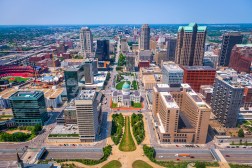Want to become a smart city? Start with an innovation district

Becoming a smart city may sound like an elusive dream. With so many different approaches and applications to choose from, diving into this relatively new and unfamiliar realm seems both risky and daunting, but the good news is that cities don’t need to jump headfirst into smart technology and immediately install connected devices and environmental monitors on every street corner.
Instead, the easier — and wiser — route is to begin your foray by creating an innovation district.
Innovation districts allow cities to test different pieces of smart technology, pick and choose the best options, and then scale them throughout the rest of the municipality. As of late 2016, more than 80 cities across the globe were actively taking this approach.
One such city is Las Vegas, Nevada, an area that not only serves 600,000 citizens, but one that also attracts millions of visitors annually. Excessive traffic congestion, poor waste management, and high environmental emissions could combine to make this tourist attraction far less attractive — which would eventually cripple the city’s economy.
The city’s leaders knew smart technology could help monitor and control these factors, but they weren’t quite sure where to start. So, through a partnership with my company, they created an innovation district adjacent to the Las Vegas Strip where they actively test various combinations of monitors and tools. Along the way, they’ve gathered key insights regarding the region and identified which pieces of technology will help them best achieve their goals.
Denver is another city with a thriving innovation district. Peña Station Next is an underdeveloped area Panasonic is currently outfitting with a solar-powered microgrid and other renewable and autonomous technologies. The city is breaking ground this month on its first series of apartments that will enjoy high-density Wi-Fi, air quality monitoring, and an autonomous shuttle to the nearby rail stop.
Denver and Las Vegas are just two of many municipalities that have elected to build innovation districts before making citywide investments in smart technology. Here’s a closer look at the three biggest benefits of taking this approach:
Immediate actionable insights
Though they serve as test areas that empower large-scale smart technology deployment, innovation districts still provide operational insights cities can act upon in the short term.
Las Vegas, for example, used data from its innovation district to optimize the Strip’s waste management system. The city is considering installing trash can monitors to ensure public waste receptacles are never too full — an improvement citizens and visitors will surely appreciate. Meanwhile, Las Vegas is also in the process of developing a well-informed, long-term plan for scaling smart technology solutions into other parts of the city.
Low-cost proof of concept
Innovation districts provide accurate proof of concept because they are deployed in the real world. Quality testing is an important aspect of any new technology implementation. A solution may look great on paper, but it needs to be both practical and scalable to succeed in real life.
Innovation districts allow cities to determine this practicality and ensure a successful outcome before making a hefty investment. Local governments spent an estimated $52.4 billion on IT in 2016 — a figure that’s consistently on the rise. Innovation districts can reverse this trend.
Growth and new ideas
Innovation districts help cities promote commerce, growth, and public recognition. They serve as demonstration areas for solution providers, which inevitably leads to visits from CIOs and investors alike. Further, these areas also create local skilled jobs in technology, marketing, life sciences, and more.
Barcelona’s 22@District is a shining example of just how much growth innovation districts can promote. Over a 10-year period, 22@District’s population grew 23 percent.
Smart city technology is more than just a trendy buzzword — it’s how cities around the world are collecting and analyzing data to optimize operations and improve life for everyone.
Becoming a smart city is less daunting than it seems — it only takes one small district at a time.






